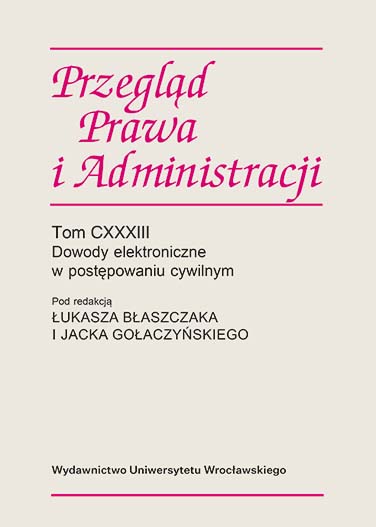Pojęcie dokumentu elektronicznego w prawie cywilnym
The concept of electronic document in civil law
Author(s): Jacek GołaczyńskiSubject(s): Law, Constitution, Jurisprudence, Civil Law
Published by: Wydawnictwo Uniwersytetu Wrocławskiego
Keywords: document; handwritten signature; electronic signature; written form; electronic form; documentary form
Summary/Abstract: According to the Civil Code, a document is a carrier which makes it possible to get familiar with information (Article 773 of the Civil Code). Whereas according to Art. 3 Sec. 2 of the Act on informatization of the activity of entities performing public functions, an electronic document is a set of data constituting a separate entity, set in a specific internal structure and recorded on a computer data carrier.It follows from the above that both definitions will apply in the public procurement proceedings, while according to the Civil Code, an electronic document is a carrier containing information, and according to Article 3 Sec. 2 of the Act on informatization, an electronic document is information recorded on a computer data carrier.An electronic document can be created in various ways, with the use of specific software, so it can contain text elements created with the use of a text editor, graphic elements, photos, charts, drawings and even audio or audiovisual elements. Therefore, the nature and form of an electronic document cannot be specified in advance.According to the Code of Civil Procedure, evidence from an electronic document containing a text and making it possible to determine its author is subject to the provisions on evidence from documents (Article 2431 of the Code of Civil Procedure), and other documents, which apart from the text also contain audio, video, graphic files, etc., are subject to the provisions of Article 308 of the Code of Civil Procedure. In both cases, the court may admit visual and expert evidence for the purpose of such proof.An electronic document may be submitted in its original form, e.g. on a carrier or through access to a given IT system containing information which is the subject of evidence. It may also be submitted in the form of a copy, which must be a faithful representation of the original. Documents in electronic form may be submitted to the case file in pending civil proceedings in three forms: as electronic information carriers on which data are recorded, as a visualisation on a computer screen or as a computer printout. When it concerns a document originally drawn up in a paper form, it will be necessary to make an electronic certification of the document. Currently, the provision of Art. 129 § 21 of the Code of Civil Procedure provides that “electronic certification of a copy of a document provided by a professional representative acting in the case who is an attorney, a legal adviser […] takes place at the moment of introducing this document into the ICT system. Electronic certification of a document may also be performed by a public notary.”The signature must be handwritten, although it may only contain the name or a pseudonym under which a person is identified. A paraphrase, containing an abbreviated signature or initials, is not considered as a handwritten signature. A mechanically reproduced signature is a copy of a handwritten signature, which may be made by means of a photocopying, photographic, digital or other method, but such a reflection of the signature does not constitute a handwritten signature, which is an element of the written form of legal transactions.
Journal: Przegląd Prawa i Administracji
- Issue Year: 133/2023
- Issue No: 1
- Page Range: 33-56
- Page Count: 24
- Language: Polish

